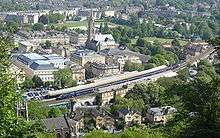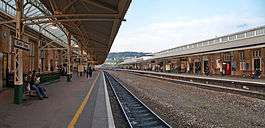Bath Spa railway station
| Bath Spa | |
|---|---|
|
Bath Spa platforms | |
| Location | |
| Place | Bath |
| Local authority | District of Bath and North East Somerset |
| Coordinates | 51°22′39″N 2°21′23″W / 51.3775°N 2.3564°WCoordinates: 51°22′39″N 2°21′23″W / 51.3775°N 2.3564°W |
| Grid reference | ST752643 |
| Operations | |
| Station code | BTH |
| Managed by | Great Western Railway |
| Number of platforms | 2 |
| DfT category | C1 |
|
Live arrivals/departures, station information and onward connections from National Rail Enquiries | |
| Annual rail passenger usage* | |
| 2010/11 |
|
| – Interchange |
|
| 2011/12 |
|
| – Interchange |
|
| 2012/13 |
|
| – Interchange |
|
| 2013/14 |
|
| – Interchange |
|
| 2014/15 |
|
| – Interchange |
|
| History | |
| Original company | Great Western Railway |
| Pre-grouping | Great Western Railway |
| Post-grouping | Great Western Railway |
| 31 August 1840 | Opened as Bath |
| 1949 | Renamed Bath Spa |
| National Rail – UK railway stations | |
| * Annual estimated passenger usage based on sales of tickets in stated financial year(s) which end or originate at Bath Spa from Office of Rail and Road statistics. Methodology may vary year on year. | |
|
| |
Bath Spa railway station is the principal station serving the city of Bath, South West England. It is on the Great Western Main Line, 106 miles 71 chains (172.0 km) down-line from London Paddington and situated between Chippenham to the east and Oldfield Park and to the west. Its three-letter station code is BTH.
The station is currently managed by Great Western Railway, and it is served by trains operated by Great Western Railway, South West Trains and CrossCountry.
Architecture

Bath Spa station was built in 1840 for the Great Western Railway by Brunel and is a Grade II* listed building.[1] It is in an asymmetrical Tudor style with curving gables, and lies on the north bank of the Avon, with the line curving across from the southern bank to the station and then back again.[2] Opened on 31 August 1840, the station was originally named Bath, but was given its present name of Bath Spa in 1949 to distinguish it from Bath Green Park station, which did not have its name altered from Bath until 1951.[3]
A convenient feature for passengers was the ramps that led up to both platforms, giving the disabled and those with luggage easy access from the platforms to cars or taxis. However, in 2011 the northern ramp was removed in a station redevelopment which provided lifts instead. There is also a footbridge leading directly from the station across the Avon and allowing direct access to the Widcombe area. It was originally tolled, and informally known locally as the Ha'penny Bridge; it was reconstructed in 1877.[4]
The station has wide spacing between the platforms: there were originally two broad gauge carriage sidings between the platform lines. The station was first built with a hammerbeam roof covered the area between the platforms, however this was removed in 1897 when the station was remodelling with longer platforms.[1][5] The station originally had a three track goods shed immediately west of the station, to the north of the main track. In 1877 a large goods depot was built about 500 metres to the west at Westmoreland, and the goods shed was demolished for the station remodelling in 1897.[5]
Services
All of Bath's rail services run through Bath Spa station; it is conveniently situated for transfer to bus services.
The station has regular (approximately half-hourly each way) inter-city services to London Paddington via Swindon, Reading and Chippenham and to Bristol Temple Meads (with extensions to Weston-super-Mare, Taunton, the county of Devon and Cornwall).
It is also served hourly (two-hourly on Sundays) by the Cardiff Central to Portsmouth Harbour and Gloucester & Bristol to Westbury and Weymouth regional trains, plus a limited service to London Waterloo via Salisbury and Basingstoke operated by South West Trains. South West Trains operate three direct services per day Monday-Saturday and two on Sunday. In addition, there is an early morning Basingstoke to Bristol Temple Meads service which calls at Bath Spa. Finally, they operate a late evening Bristol Temple Meads to Salisbury service. This is the last train of the day to Warminster railway station and Salisbury.[6][7] These services are operated by British Rail Class 159 units, although British Rail Class 158 units have been seen on occasions.[8]
Since the May 2010 timetable started, an early morning CrossCountry service to Glasgow Central via Bristol, Birmingham, Sheffield, Leeds, Newcastle and Edinburgh starts at Bath. It departs at 06:09 on Mondays to Fridays, but does not run at weekends. It arrives in Glasgow at 14:12. There is no southbound return service.[9]
Torbay Express LTD's Torbay Express calls at Bath on certain Sundays between July and September. This was first run in Summer 2014 when engineering works between Bristol and Taunton closed the line and so The Torbay Express was diverted via Bath and Westbury. This proved so popular that for the 2015 season, certain Torbay Express' ran via Bath and Westbury calling at: Bath, Trowbridge and Westbury before rejoining the normal route at Cogload Junction just north of Taunton.
| Preceding station | |
Following station | ||
|---|---|---|---|---|
| Bristol Temple Meads | Great Western Railway London – Bristol/West Country |
Chippenham | ||
| Oldfield Park | Great Western Railway Great Malvern/Gloucester – Westbury/South Coast |
Freshford | ||
| Oldfield Park | Great Western Railway Weymouth Wizard (Summer Saturdays Only) |
Bradford-on-Avon | ||
| Keynsham | Great Western Railway Cardiff Central – Portsmouth Harbour |
|||
| South West Trains London Waterloo – Bristol |
||||
| Terminus | CrossCountry Cross Country Route One northbound early morning journey |
Bristol Temple Meads | ||
Redevelopment

Since railway privatisation Great Western Railway has managed Bath Spa. In 2005 they obtained listed building consent for a number of alterations to the building, including the installation of lifts to the platforms. Ticket barriers have also been installed.[10]
Other developments started in 2011 to more closely integrate the station with the new Bath bus station and SouthGate shopping centre,[11] and redevelop some of the station car park and northern ramp into a restaurant complex at a cost of £12 million.[12] There are also plans to change some arches at the station to encourage retail use.[13]
Bath Spa won awards for Best Medium-Sized Station and Overall Best Station at the 2013 International Station Awards.[14]
Other stations in Bath
Railway Stations in Bath |
|---|
Legend |
The only other open station in Bath is Oldfield Park, a small commuter station in a western suburb, with limited services to Bristol and to Bath Spa, and onward stations.[15]
Former stations now closed in Bath were Green Park (the Midland terminus, whose overall roof and primary buildings survive, and which for part of its life was named "Bath Queen Square"),[16] Bathampton and Weston (a suburban station on the Midland line which closed in 1953). Westmoreland Street, later a goods station, was the original GWR passenger station, and has now been demolished. Twerton-on-Avon, and Hampton Row Halt, both on the GWR route, closed in 1917 as a World War I economy measure.[17]
References
- 1 2 "Bath Spa Station". Listed Buildings Online. Retrieved 27 December 2011.
- ↑ "Avonside House Design and Access Statement" (PDF). Bath and North East Somerset Council. Retrieved 1 January 2012.
- ↑ Butt, R.V.J. (1995). The Directory of Railway Stations. Yeovil: Patrick Stephens Ltd. p. 29. ISBN 1-85260-508-1. R508.
- ↑ "A Short History of Widcombe". Widcombe Association. Retrieved 1 January 2012.
- 1 2 Goods shed, Bath Spa Station, Bath - Historic Building Assessment (PDF) (Report). Oxford Archaeological Unit. 10 March 2000. Retrieved 22 February 2015.
- ↑ "Archived copy" (PDF). Archived from the original (PDF) on 12 May 2013. Retrieved 2013-06-08.
- ↑ "Archived copy". Archived from the original on 30 May 2013. Retrieved 2013-06-08.
- ↑ http://www.railfaneurope.net/pix/gb/diesel/dmu/158/SWT/BTM-158786-02.jpg
- ↑ "CrossCountry May 2010 Rail Timetable" (PDF). Retrieved 16 June 2010.
- ↑ "Gating proposal for Bath Spa Station ticket hall" (PDF). Bath and North East Somerset Council. Retrieved 1 January 2012.
- ↑ "Bath Southgate Transport Interchange" (PDF). Southgate Bath. Archived from the original (PDF) on 26 April 2012. Retrieved 1 January 2012.
- ↑ "First image of £12m Bath restaurant scheme". Bath Chronicle. 8 December 2011. Retrieved 7 January 2012.
- ↑ "Retail Proposals at Bath Spa Railway Station, Bath" (PDF). Oxford Architects. Bath and North East Somerset Council. Retrieved 1 January 2012.
- ↑ Harris, Nigel, ed. (25 December 2013). "Awards for Bath Spa". RAIL. No. 738. Haymarket. p. 12.
- ↑ "Oldfield Park". The Heart of Wessex Line 2010. Retrieved 1 January 2012.
- ↑ "The Midland Railway". Bristol and Bath Railway Path. Retrieved 1 January 2012.
- ↑ Mike Oakley, (2002). Somerset Railway Stations. Dovecote Press, Wimborne. ISBN 1-904349-09-9.
External links
| Wikimedia Commons has media related to Bath Spa railway station. |
